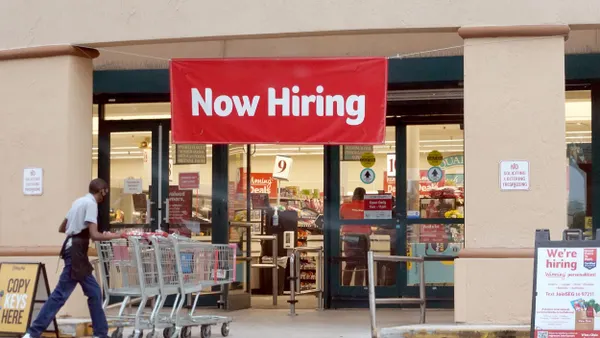Dive Brief:
- Sponsorships can help close the wage gap, especially for black and Hispanic women, a new PayScale report showed — but often, white men receive sponsorship more often and benefit more from sponsorship. The report, Sponsors: Valuable Allies that Not Everyone Has, was a call for organizations to "recognize and address the unconscious bias that exists in most organizations," whereby white males routinely sponsor mostly fellow white males for advancement opportunities and higher pay, PayScale said.
- In key findings from the report, employees who have sponsors are paid 11.6% more than those who do not, and men with sponsors receive higher pay (12.3%) than sponsored women (10.2%). Women who have female sponsors make 14.6% less than those who have male sponsors, and men who have female sponsors earn 8.7% less than men with male sponsors. The report also found that black women with a black sponsor earned 11.3% less than those with a white sponsor, and Hispanic women with a Hispanic sponsor earned 15.5% less.
- "Our new report shines a light on the fact that white, male leaders should actively look for opportunities to advocate for people who don't look like them. Human bias is entrenched in the workplace and sponsorship programs that don't address it will result in the continued prevalence of primarily white, male leadership on our nation's boards and executive teams," PayScale Director Wendy Brown said in a media release.
Dive Insight:
Cigna's Women in Leadership study found that 80% of respondents agreed that women need the support of other women to advance in their organizations. But based on PayScale's report, having a white male advocate is valuable for women when compensation and career opportunities are factors.
For sponsorships to work, participants must understand their roles. A study from the Center for Talent Innovation found that sponsors weren't performing their role to advocate for their protege's promotion; less than a third surveyed advocated for their protégé's promotion, and the majority (71%) chose to sponsor someone from their own race or gender.
In setting up sponsorship programs, organizations must understand the difference between sponsoring and mentoring. Betty Spence, president of the National Association for Female Executives, told HR Dive in a 2017 interview that mentorship entails a seasoned person providing advice and career guidance to a person on the way up, whereas sponsors partner with others who are ready for other opportunities, including advancement, and vouch for their achievements.
Organizations can look for other ways to close the gender gap through partnering with other organizations. Sodexo North America teamed up with other organizations for the Paradigm for Parity Initiative, for which companies strive to meet diversity and inclusion goals partly through creating sponsorships for women and raising retention rates among underrepresented groups in the workplace.
For their part, women can direct change in career advancement and compensation by being more willing to take risks, which might include requesting a sponsor, raise, promotion or prime assignment. HR managers might encourage risk taking among women as part of their company's learning and development programs.












